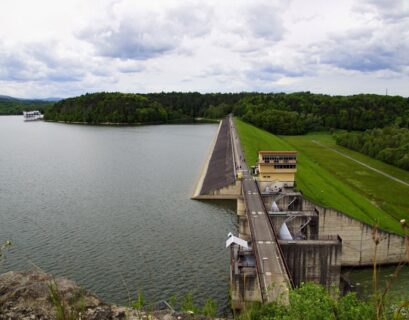Long-term forecasting was one of the most significant challenges of the 20th century. The most difficult task had those who dealt with areas located in climatic zones with transitional or intermediate features, such as Polish scientists. Poland is a textbook example of a warm temperate transitional climate, characterised by very high variability of weather conditions.
The first Polish forecasts were developed in the 1950s when computer programs began to be used for weather prediction. At the State Hydrological and Meteorological Institute (PIHM), today IMGW-PIB, the Department of Long-Range Forecasts, headed by Józef Lityński, was established in 1956. One year later, the first analogue harmonic analyser (AAH) in Europe was constructed at the Institute of Fundamental Technological Research of the Polish Academy of Sciences. The project was headed by Jacek Karpiński, Eng., an outstanding electronics engineer and computer scientist. The analyser consisted of 650 electron tubes, had dimensions of 1.5×2 m, and performed calculations of large data sets using Fourier harmonic analysis. The device made it possible to create long-term statistical models used to prepare forecasts of monthly-mean air temperature and total precipitation for Warsaw. It was a breakthrough, supported by numerous scientific studies. In 1965, the article “Statistical methods in long-range weather forecasting” by Zdzisław Kaczmarek and Józef Lityński containing a description of the analyser and the results of its calculations was published in the report of the World Meteorological Organisation (WMO).

The key is statistical models. From the beginning of the Department of Long-Range Forecasts operation, teams of meteorologists, climatologists, geophysicists, and mathematicians were learning the secrets of processes occurring in the atmosphere and influencing the weather in Poland. The development of algorithms for statistical models was based on analogue forecasting method. This method of weather prediction is based on the assumption that similar atmospheric processes lead to similar effects. Comparing current atmospheric processes with past processes enables the preparation of a forecast for a certain period, e.g. a month or a season.
The crucial role in the applied methods was played by selecting appropriate variables describing the atmospheric processes occurring in the time preceding the forecast period (predictors) and variables describing the weather course in the forecast period (predicted variables). The most common predictors were monthly-mean and seasonal-mean, daily values of the atmospheric circulation and atmospheric pressure indexes in selected points of Europe and the North Atlantic, air temperature and precipitation in Warsaw, as well as the geopotential field of 500 hPa and relative topography between 500 hPa and 1000 hPa at grid knots in the northern hemisphere. The predicted variables were monthly-mean air temperature and total precipitation in Warsaw. The selection of predictors and predicted variables was made based on numerous studies conducted in the 1960s and 1970s, by among others, Maria Wodzińska, Zdzisław Kaczmarek, Jan Malicki, and Albin Cisak. The two atmospheric circulation classification systems developed by Blanka Osuchowska-Klein and Józef Lityński made an invaluable contribution to this research.
Based on the acquired knowledge and due to rapidly developing computational techniques, in the late 1970s, the Department of Long-Range Weather Forecasts initiated the preparation of monthly and seasonal forecasts of the average air temperature and precipitation total for a more significant number of points, i.e. for 18 cities in Poland (previously only for Warsaw ). It was undoubtedly another breakthrough in improving long-term forecasts. Research on new models was also initiated, e.g. in the 1980s, a spectral hemispheric model for the northern hemisphere was launched using a modern Odra series computer. In the 1990s, an attempt was made to apply neural networks and chaos theory. At the beginning of the 21st century, atmospheric circulation types, according to Lityński, were again used in forecasting models. These works were related to participation in a project on the harmonisation and applications of weather types classifications for European regions under the European Cooperation in Science and Technology Programme (COST ACTION 733, 2014). They resulted in an update of circulation types carried out by Krystyna Pianko-Kluczyńska.
A significant step into the 21st century. At the beginning of the present century, the Department of Long-Range Weather Forecasts, which after Józef Lityński was headed successively by Maria Wodzińska, Bogumił Jakubiak, and Stanisław Ryszard Kozieł, ceased to exist and its duties were taken over by the Central Meteorological Forecasting Office. In 2009, an organisational unit was re-established under the Department of Climate Modelling and Seasonal Forecasts (Adam Jaczewski became its head). In 2015 the competencies in the area of long-range forecasts were taken over by the National Meteorological Protection Centre. Forecasting methods were changing with the development of numerical techniques and broader access to prognostic information from various global meteorological centres. The results of numerical models began to be used in statistical methods. In 2016, Krystyna Pianko-Kluczyńska developed a statistical model of partially probabilistic 30-day forecasts of the IMGW-TWS, using GFS numerical forecasts as input. The model, based on advanced fuzzy logic methods, forecasts the probability of occurrence of the following classes: below average, within average, and above average for the mean temperature, total precipitation, and number of days with precipitation for the entire forecasting period, and also – for each of the three consecutive decades of the month – ranges of minimum and maximum air temperature, number of days with precipitation and number of days with snowfall. In 2018, the IMWM-Reg cluster statistical model was developed by Krystyna Konca-Kędzierska. It predicts the monthly-mean air temperature, total precipitation, and the number of days with precipitation up to six months ahead using the partial regression method. In the same year, Krystyna Pianko-Kluczyńska proposed the first version of the IMGW-Bayes probabilistic statistical model, which uses the probability theory and Bayes theorem (naive Bayes classifier). It forecasts, up to a maximum of five months ahead, the probability of occurrence of monthly-mean air temperature, monthly precipitation, and the number of days with precipitation in three classes: above average, within average, and below average. Another bundled version of the IMGW-Bayes model was implemented in 2021.
In 2020, the Meteorological Modelling Centre was established at the Institute of Meteorology and Water Management, headed by Prof. Mariusz Figurski. The Department of Meteorological Analyses and Long-Range Forecasts was established within the structures of this unit under the leadership of Marta Gruszczyńska. The Department pursues tasks related to, among other things, developing the first ensemble long-term numerical model for the area of Poland (WRF-CFS model), developing current statistical-numerical models (IMGW-TWS, IMGW-Reg) and statistical models (IMGW-Bayes), analysis of verifiability and possibility of using the results of long-range global models (ECMWF and NOAA models), working out a new method of forecast presentation, as well as the implementation of the latest technological solutions, e.g., multimodel integrating many models using artificial intelligence and machine learning algorithms.
Good to know
COST
The European Cooperation in Science and Technology, https://www.gov.pl/web/edukacja-i-nauka/europejski-program-wspolpracy-w-dziedzinie-badan-naukowo-technicznych-cost, https://www.cost.eu/.
ECMWF
European Centre for Medium-Range Weather Forecasts, https://www.ecmwf.int/.
IMGW-TWS
Numerical-statistical forecasting model, developed and improved at IMGW-PIB. It is based on advanced fuzzy logic methods. Data from NCEP/NCAR reanalyses, the GFS 1° model, and meteorological stations of IMGW-PIB are applied for calculations. The model forecasts the ranges of minimum and maximum air temperature, the number of days with precipitation, and the number of days with snowfall that should occur in each of the three consecutive decades in forecasting periods starting on the 1st, 11th, and 21st day of the month. A forecast is prepared for 87 meteorological stations in Poland. Currently, IMGW-PIB makes available results for 13 mountain stations on the website góry.imgw.pl.
IMGW-Reg
Numerical-statistical forecasting model was developed and improved at IMGW-PIB. It forecasts the monthly-mean air temperature and monthly total precipitation together with the predicted value’s standard deviation (+/-). The model applies the partial regression method, taking quantile fields of selected meteorological variables from NCEP/NCAR reanalyses as predictors. The forecast is calculated for 20 selected cities in Poland. The model results are used to develop the experimental long-range temperature and precipitation forecast.
IMGW-Bayes
A statistical forecasting model was developed and improved at the Institute of Meteorology and Water Management. It is based on probability theory and Bayes’ theorem (naive Bayes classifier). The model forecasts the probability of occurrence of monthly-mean air temperature and monthly total precipitation in the following classes: above average, within averagenormal, and below average (the model results do not include information, as long as the predicted value is lower than the lower limit of the average or higher than the upper limit of average). Data from NCEP / NCAR reanalyses are used in calculations that concern selected meteorological fields from different levels of the troposphere and stratosphere. The forecast is made for 87 meteorological stations in Poland. The model results are applied to make an experimental long-range temperature and precipitation forecast.
NOAA
National Oceanic and Atmospheric, https://www.noaa.gov/.
WMO
World Meteorological Organization, https://public.wmo.int/en.
WRF-CFS
Long-term deterministic weather model applying numerical weather model WRF (Weather Research and Forecasting Model) and the results of the global model CFS (Climate Forecast System), https://www.mmm.ucar.edu/weather-research-and-forecasting-model, https: //www.ncei.noaa.gov/products/weather-climate-models/climate-forecast-system.
Authors: Krystyna Pianko-Kluczyńska, Krystyna Konca-Kędzierska, Adam Jaczewski, Alan Mandal, Radosław Droździoł, Marcin Wdowikowski, Zofia Bałdysz, Weronika Wrońska, Karina Kózka, Grzegorz Nykiel, Tomasz Strzyżewski, Marta Gruszczyńska| Meteorological Modelling Centre, IMGW-PIB.
Main photo: Daria Tumanova | Unsplash.








